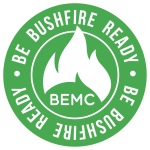Accurately referred to as the sunburnt country, Australia is no strangers to the harsh reality of bushfires. Bushfires are part of our national identity and understanding this powerful phenomenon is crucial to living safely and sustainably within our unique environment.
What Is A Bushfire?
A bushfire is an uncontrolled fire that occurs in the bush, woodland or grasslands of Australia. It’s a natural occurrence in Australian ecosystems, helping rejuvenate vegetation and contributing to our country’s unique biodiversity. However, when these fires occur near populated areas or aren’t properly regulated, they can pose serious risks humans, properties and the environment.
How Do Bushfires Start?
Most bushfires start from natural causes such as lightning strikes, but they can also be ignited by human activities, both intentional and accidental. Campfires, discarded cigarette butts, sparks from machinery and even glass bottles can all trigger a bushfire when conditions are dry and hot.
How Do Bushfires Spread?
Bushfires spread through the transfer of heat across three mediums: through direct contact, radiant heat or by transporting burning materials. Weather plays a pivotal role as well, with wind changes often exacerbating the speed and direction of a bushfire’s spread. If conditions are dry and breezy, a bushfire can spread very rapidly.
What Should You Do During A Bushfire?
During a bushfire, your primary goal should be safety – yours and that of others around you. Stay informed with regular updates from authorities and execute your Bushfire Survival Plan. This customised guide helps to ensure you know when to stay, when to go and how to protect your home in the event of a bushfire.
How Do Bushfires Affect The Environment?
Bushfires can have a significant impact on the environment. While some Australian vegetation relies on fire for regeneration, without proper planning, they can lead to a loss of native flora and fauna, habitat destruction, soil erosion and changes to water quality.
How Can We Prevent Bushfires In Australia?
Preventing bushfires in Australia involves a concerted effort from everyone. Strategies include:
- Controlled Burning: Reducing fuel load in bushland areas to prevent larger, uncontrolled fires. Everyone should be vigilant and responsible when in fire-prone areas, particularly during bushfire season. Controlled Burning should only be performed by a certified controlled burning contractor.
- Bushfire Survival and Emergency Planning: Having a well-formulated bushfire emergency plan in place could represent the difference between life and death. Develop comprehensive strategies that identify hazards, while balancing human safety with cultural and environmental considerations. Your plans should include a clear set of procedures you can implement in the event of a bushfire to minimise risk to occupants and assets.
- Building & Planning Compliance: Ensure your property is compliant with all local bushfire regulations. This is essential if you ever need to make an insurance claim relating to bushfire damage. Obtain a Bushfire Attack Level (BAL) certificate to confirm your business does not fall into the flame zone and that protection measures are in place for water, gas and electrical systems.
- Contacting a Bushfire Consultant: A seasoned consultant can inspect and assess the risk of bushfire damage at your property, providing advice on how to mitigate risk and remain compliant with safety regulations. They can provide detailed reports regarding your property’s bushfire safety by assessing access points, asset protection zones, distances from vegetation, water supply, landscaping factors and more.
Want To Minimise Risk And Maximise Peace Of Mind?
The Bushfire and Environmental Management Consultancy (BEMC) specialises in bushfire and land management services for Newcastle, Port Stephens, the Hunter Valley, Central Coast, and surrounding areas. Our experienced bushfire consultants can provide thorough consultations, strategic management plans, assessment reports, attack level ratings and other planning for your property to help you mitigate the risks associated with bushfires.








